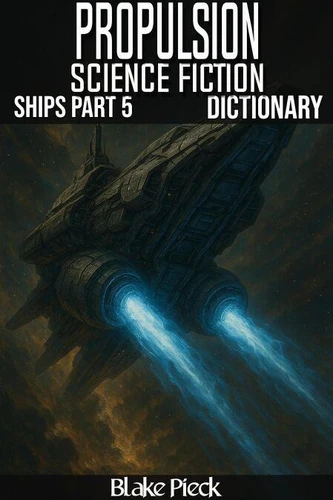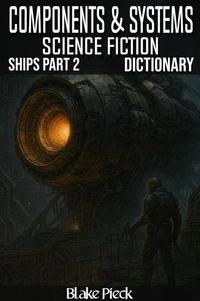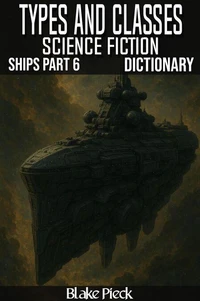Nouveauté
Propulsion Technologies Dictionary - Spaceships Part 5 - Science Fiction. Grow Your Vocabulary
Par :Formats :
Disponible dans votre compte client Decitre ou Furet du Nord dès validation de votre commande. Le format ePub est :
- Compatible avec une lecture sur My Vivlio (smartphone, tablette, ordinateur)
- Compatible avec une lecture sur liseuses Vivlio
- Pour les liseuses autres que Vivlio, vous devez utiliser le logiciel Adobe Digital Edition. Non compatible avec la lecture sur les liseuses Kindle, Remarkable et Sony
 , qui est-ce ?
, qui est-ce ?Notre partenaire de plateforme de lecture numérique où vous retrouverez l'ensemble de vos ebooks gratuitement
Pour en savoir plus sur nos ebooks, consultez notre aide en ligne ici
- FormatePub
- ISBN8231657575
- EAN9798231657575
- Date de parution18/08/2025
- Protection num.pas de protection
- Infos supplémentairesepub
- ÉditeurWalzone Press
Résumé
Spaceships Propulsion Technologies is a focused reference on the systems that drive spacecraft across the void. Instead of looking at broader ship operations or crew functions, this volume concentrates entirely on the engines, drives, and power methods that make interstellar travel possible. Each entry is written in a structured format, explaining how a propulsion technology works and why it is vital to the performance of a ship.
The book explores a wide range of concepts, from traditional chemical rockets and nuclear drives to advanced theoretical engines such as antimatter reactors and warp systems. It also covers supporting technologies like fuel storage, energy transfer, and thrust control, showing how each element contributes to the movement and maneuverability of a vessel. With no reliance on diagrams or illustrations, the emphasis remains on clear and detailed descriptions that bring complex engineering ideas within reach of the reader.
This dictionary is intended for writers, creators, and science fiction enthusiasts who want to build convincing accounts of how ships move through space. Whether describing small exploratory craft or immense battleships, the entries provide the vocabulary and insight needed to give propulsion systems depth and believability in any story.
The book explores a wide range of concepts, from traditional chemical rockets and nuclear drives to advanced theoretical engines such as antimatter reactors and warp systems. It also covers supporting technologies like fuel storage, energy transfer, and thrust control, showing how each element contributes to the movement and maneuverability of a vessel. With no reliance on diagrams or illustrations, the emphasis remains on clear and detailed descriptions that bring complex engineering ideas within reach of the reader.
This dictionary is intended for writers, creators, and science fiction enthusiasts who want to build convincing accounts of how ships move through space. Whether describing small exploratory craft or immense battleships, the entries provide the vocabulary and insight needed to give propulsion systems depth and believability in any story.
Spaceships Propulsion Technologies is a focused reference on the systems that drive spacecraft across the void. Instead of looking at broader ship operations or crew functions, this volume concentrates entirely on the engines, drives, and power methods that make interstellar travel possible. Each entry is written in a structured format, explaining how a propulsion technology works and why it is vital to the performance of a ship.
The book explores a wide range of concepts, from traditional chemical rockets and nuclear drives to advanced theoretical engines such as antimatter reactors and warp systems. It also covers supporting technologies like fuel storage, energy transfer, and thrust control, showing how each element contributes to the movement and maneuverability of a vessel. With no reliance on diagrams or illustrations, the emphasis remains on clear and detailed descriptions that bring complex engineering ideas within reach of the reader.
This dictionary is intended for writers, creators, and science fiction enthusiasts who want to build convincing accounts of how ships move through space. Whether describing small exploratory craft or immense battleships, the entries provide the vocabulary and insight needed to give propulsion systems depth and believability in any story.
The book explores a wide range of concepts, from traditional chemical rockets and nuclear drives to advanced theoretical engines such as antimatter reactors and warp systems. It also covers supporting technologies like fuel storage, energy transfer, and thrust control, showing how each element contributes to the movement and maneuverability of a vessel. With no reliance on diagrams or illustrations, the emphasis remains on clear and detailed descriptions that bring complex engineering ideas within reach of the reader.
This dictionary is intended for writers, creators, and science fiction enthusiasts who want to build convincing accounts of how ships move through space. Whether describing small exploratory craft or immense battleships, the entries provide the vocabulary and insight needed to give propulsion systems depth and believability in any story.























